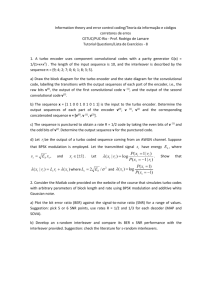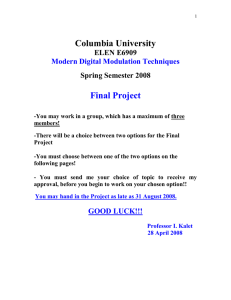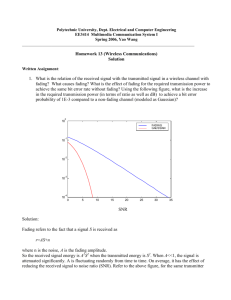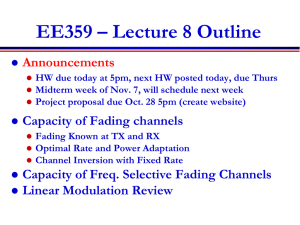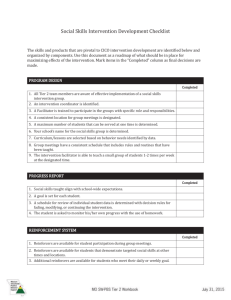Optimal Power Control for Convolutional and n r b o ... over Fading Channels Sharma S. Ahuja,
advertisement
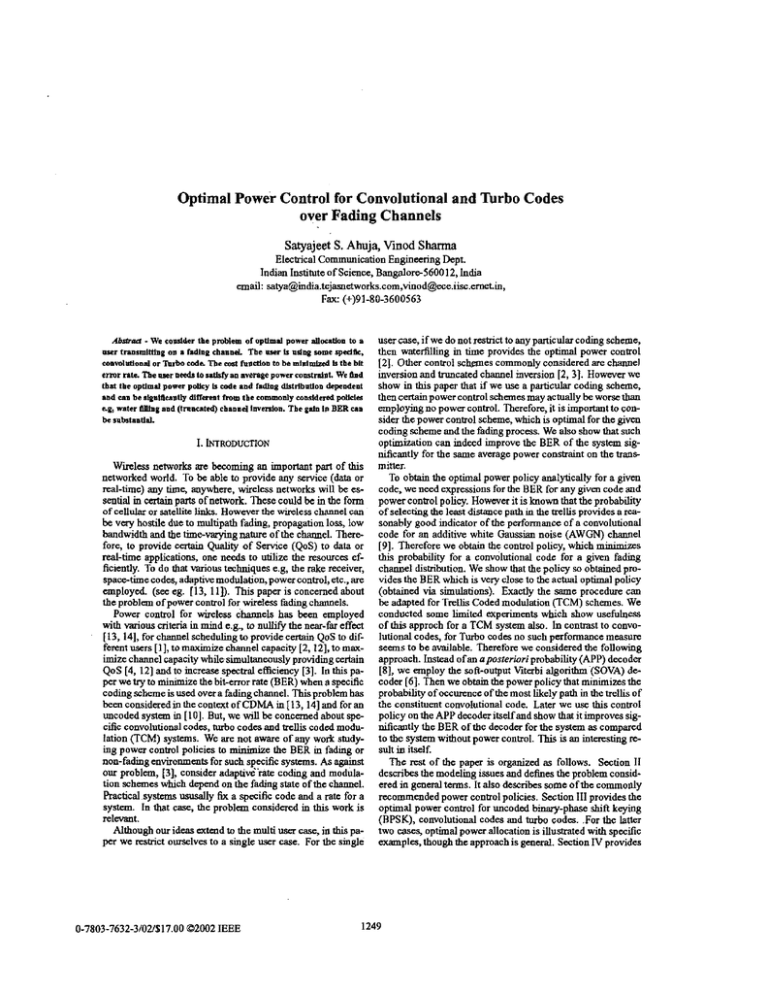
Optimal Power Control for Convolutional and n r b o Codes
over Fading Channels
Satyajeet S. Ahuja, Vinod Sharma
Electrical Communication Engineering Dept.
Indian Institute of Science, Bangalom560012, India
email: satya@india.tejasletworks.com,vinod@ece.iisc.met.in,
Fax: (+)91-80-3600563
-
We eoedder the pmblem of optimal power outl lam to a
user case, if we do not restrict to any particular coding scheme,
t-rmlmng
r d n g ChannL n e
LI ttslng S ~ O~ d k ,then WaterIilIing in time provides the optimal power control
e0nvolutlon.l or ? h h cod& "be mst rwxtbm to be mlnlmIz.4 Is the blt
[2]. Other control schemes commonly consideredare channel
inversion and truncated channel inversion 12.31. However we
ermrmte. The-rnedstosaUstyan avengepowueoerfralnt. Wefind
show in this paper that if we use a particular coding scheme,
that the o p t i d power p d e y Is d e and f d n g dlstlibudon dependent
and can be dgntaunUy different horn the commonly c o n r l d d pollclca thencertainpowercontrolschemesmayactuallybe worsethan
employing no power control. Therefore, it is important to con&g, water Ollln8 and (truncated) e b m n d Invvnslon. The galn le BER cm
sider the power control scheme,which is optimal for the given
b *llbStanual.
Absbnd
~
1. INTRODUCTION
Wireless networks are beconing an important part of this
networked world. To be able to provide any snvice (data or
real-time) any time, anywhere, wireless networks will be e 5
sential in certainparts of network. These could be in the form
of cellular or satellite links. However the wireless channel can
be very hostile due to multipath fading, propagation loss, low
bandwidth and the timwwyhg name of the channel. Therefore, to provide certain Quality of Service (QoS) to data or
real-time applications, one needs to utilize the resources efficiently. To do that various techniques e.g. the rake receiver,
spa-timecodes, adaptivemodulation,powercontrol,elc..are
employed. (see eg. [ 13, 1I]). This paper is concerned about
the problem of power control for,wireless fading channels.
Power control for wireless channels has been employed
with various criteria in mind e.g., to nullify the near-far effect
[13,14],forchannelschedulingtoprovidecertainQoStodifferent u m s [I], to maximize channel capacity 12, 121, to maximize channel capacity wbilesimultanenuslyproviding certain
QoS [4, 121 and to increase spec& efficiency131. In this paper we try to minimize the bit-error rate (BER) when a specific
coding scheme is used overa fading channel. This problem has
been considered in the context of CDMA in [13,14] and for an
uncoded system in [IO]. But, we will he concerned about speciiic convolutionalcodes, mho codes and tellis coded modulation (TCM) systems. We are not aware of any work studying power control policies to minimize the BER in fading or
non-fading environments for such specific systems. As a@+
our problem, [3], consider adaptivekite coding and modulation schemes which depend on the fading state of the channel.
Practicahystems ususally fix a specific code and a rate for a
system. In that case, the problem considered in this work is
relevant
Although our ideas extend to the multi um case, in this paper we restrict ourselves to a single user case. For the single
0-7803-7632-3/02/$17,0002!2002IEEE
coding scheme and the fading process. We also show that such
optimization can indeed improve the BER of the system significantly for the same average power constraint on the trans
miner.
To obtain the optimal power policy analyticallyfor a given
code, we need expressions for the BER for any given code and
power control policy. However it is known that the probability
of selechg the least distance path in the a l l i s provides a reasonably good indicator of the performance of a convolutional
code for an additive white Gaussian noise (AWGN) channel
[9].Therefore we obtain the control policy, which minimizes
this probability for a convolutional code for a given fading
channel distribution. We show that the policy so obtained PICvides the BER which is very close to the actual optimal policy
(obtained via simulations). Exactly the same procedure can
be adapted for Trellis Coded modulation (TCM) schemes. We
conducted some limited experiments which show usefulness
of this approch for a TCM system also. In contrast to convolutional codes, for Turbo c o d s no such performance measure
seems to be available. Therefore we considered the following
approach. Instead ofan aposferioriprobability (APP) decoder
[SI, we employ the soft-output Viterbi algorith"(S0VA) d o
c o d a 161.Then we obtain the power policy that minimizes the
probability of occuTence of the most likely path in the tellis of
the constituent convolutional code. Later we use this control
policy on the APP decoder itself and show that it improves significantly the BER of the decoder for the system as compared
to the system without power control. This is an interesting result in itself.
The rest of the paper is organized as follows. Section I1
describes the modeling issues and defines the problem considered in general terms. It also describes some ofthe commonly
recommended power control policies. Section I11 provides the
optimal power control for uncoded binary-phase shift keying
(BPSK), convolutional codes and turbo codes. .For the latter
two css~s,optimal power allocation is illustrated with speciiic
examples, though thc approach is gened. Section IV provides
1249
Channel Inversion [Z, 3, 131 : l l u s policy ensures that
the receiver sees a conslant SNR, i.e., a:P(at) = 8, where 9
,
is chosen to satisfy (2) with equality. This is a commonly used
policy in practice.
a comparison of the optimal power control policies via simulation.
11. THESYSTEM MODELAND PROBLEM DEFINITION
We consider a fading wireless channel on which a user trans
mits his information. We study the discrete real-valued models
of the system (generalization to complex valued is obvious).
At time t, t = 0,1,2,...,the transminer transmits the coded
symbol zt. and the fading gain of the channel is at, An additive white Gaussian noise nt corrupts the signal received at the
rccciver. We further assume that tie channel state informatlon
(CSI) (II IS avadablc at the transminer and the receivcr without
any delay. This is a commonly made assumption and can be
satisfied in varying degrees in practical systems. We I d h e r assume that the process is stationary ergodic, taking values in
a finiteset A and having the stationiuy diswibution?r. The actual fading process is nonstationay due to slow shadow fading
effects, but this component can be removed and then we o b
tain an approximately stationary fading process. Finiteness of
set A is also violated in practice (e.g., Rayleigh fading is not
finite-valued). However one can suitably quantize the fading
gains to obtain a finite-valued process.
If the transmitter obtains the channel gain at and uses power
gain P ( q ) for transmitting the symbol zt, then the received
signal gt is given by,
*
Truncated Channel Imrsion [2, 3J : When channel inversion is applied for a channel whose fading level could
be very low or zero (like the Rayleigh fading channel), one
may require an infinite average power far channel inversion.
Then (2) cannot be satisfied for any finite a. Thus inversion
of channel onlv for (I+ . > 6,. for some anorooriate nositive
consmt 8, h;s also k c n consldcrcd and in facL ' C M h
slpnificantlv ktia than channel inversion.
IU Section III we explain the optimal policies for various
coding schemes. In Section IV these optimal schemes are
compared with waterfilling and channel inversion. We have
not compared the optimal policies with truncated channel inversion because in ttns policy, one does not transmit in some
bad channel states. This changes the rate of transmission. In
case of a h e d coding scheme, for a particular convolutional
code one needs to transmit the coded bits at each time instant.
Similarly, in waterfilling, if the channel state a is very bad, the
policy may allocate P(a) = 0 (see (3)). For such cases for our
comparison purposes, we will assume that there is transmis
sion with zero power and hence there is error with probability
f (mumine all svmbols arc transmittedwith eaual orobabilitv
;bh BPSK k use:).
.. .
I
.
111. OPTIMAL
POWERCONTROLPOLICIES
We will take E[z;]=l.We assume the average power constraint
where a is a suitahlc consfant Even though other power constraints may be applicable in practice, (2) is the most commonly used assumption. One can easily modify our scheme to
include other power constraints.
Our problem will be to obtain a power control policy
P(a),a E A, which minimizes the (information) BER, while
satisfying (2). We will consider this optimization problem in
Section 111 for different coding schemes. Now we describe
some of the power control algorithms commonly used in practice.
A. Commonly Used Contml Schemes
In this section we mention some of the commonly used
control policies [2, 31. In section IV, we will compare these
policies with the optimal policies obtained in Section Ill.
Worerfrlling 12, 31 ; It has been shown in [2] that the
following algorithm, called watefling in time, maximizes
channel capacity:
1
U
I
In this section, we solve the optimization problem, which
involves minimizing the BER under the power constraint (2).
In Section 111 A we considered the uncoded system. Section
111 B and III C study the problems for convolutional codes and
turbo codes respectively.
A. Uncoded System
Consider the uncoded BPSK system, with zt E {-1, +l}.
If the power control policy is P ( a ) , when channel gain is a,
then from (1) the probability of error for a bit is (assuming
symmetry we can take zt to be +I)
Our aim is to find a power coneol policy, which minimizes (4)
subject to (2) and P(a) ? 0. Of conrse, it is easy to show that
for the optimal policy, (2) is satisfied with equality.
To solve this optimization problem, using Lagrange multipliers, we differentiate
1
0,
d~ +
7 < 709
where 7 = a; and 70 is a constant chosen so that (2) is
satislied with equality.
G A
m
x(CP(a).(a) - U )
&A
(5)
with respect to P(a) and X and solve for P(a). We obtain
the optimal solution
1250
m = - $ l n (
2x JG?T(ij
a
).
(6)
The LagrangemultiplierXisobtainedbyequatingE,[P(a)]
so obtained to (1. We observe that the optimal P(a) obtained
satisfies P ( o ) 2 0, for all a, and hence we did not have to
explicitly include this constraint.
We provide an orample to illustrate the effect of different
policies.
Example: The fading process {Q] is Markov with state space
A = {0.9,0.5,0.2}. Tramition probability matrix of at is
10.15
Figure 2: Trellis for the ConvolutionalEncoder,df,..=S
1J
{&,&,e}.
0.25
0.6
withstationarydistribution,a=
Thenoisevarience is 0.0625. The power allocation and &e BER under different policies is provided in Table I. One observes that the
waterfilling and c h e l inversion are actually worse than u s
ing no power control. However, the optimal policy improves
the BER sufficientlyenough to be useful.
As illustrated by the above example, usually the optUnal solution (6) is different from watelfilling or channel inversion.
This uncoded system was also studied in [IO] in a somewhat
different form, but no comparison of the optimal policy with
waterlilling and channel inversion was made.
B. Convolution codes
To illustrate our method for convolutional codes, we will
use the encoder shown le fig 1. It is a rate half encoder with
constraint length 3 and the free distance of the code is 5. The
trellis correspondingto it is shown in figure 2. The information
sequence entering the encoder is { z t } and the encoder output
is { z t } , zt = (z:,z:). For simplicity we m u m e that the
channel fadmg state remains constant during transmission of
where pt, = (y:, U:) is the signal vector received at the tih
transrmssion. We can easily show that
21.
and
where,
- 44P(az) - &z:P(aa),
E X = -8a:P(al)
(8)
+ 16o:P(az) + 3 2 a l ~ ( a j ) ) . (9)
un = o\/(32at~(al)
Figure 1: ConvolutionalEncoder used
As mentioned earlier for these codes there is no explicit expression available for BER. Therefpre, we consider the most
likey error path (Iirst error event) shown in fig 2 for this decoder when all zeros have been tmnsmitted. We compute the
probability of error Pel for this path to occur, for a given fading process and a power control policy. Now to compute the
probability of error, it is not enough to know the marginal stationary probability r(a) of the fadmg process. We need the
three dimensional stationary probability r(al,az,a3). Then
P.1 is given as
One can obtain the power policy which minimizes Pelsubject to the average power constraint (2) via the method of Lagrange multipliers. We will show in the next section, via simulations that the BER of this optimal scheme is less than the
BER corresponding to the power policies explained earlier.
From the above discussion it is obvious that the same ideas
can be directly extended to TCM systems. The only problem
is that since TCM systems are not linear, it is not enough to
consider an all zero sequence as the input to the channel. One
needs to search for the most likely error path more exhaustively.
C. Turbo Codes
In this section we explain our procedure to obtain an 'optimal' power scheme for a Turbo coded system. W e consider
a Turbo coded system consisting of two recursive systematic
convolutionalencoders, the trellis for which is shown in figure
3. IfTurbodecodingisperformedusingSOVA 161, wecanapply power control by minimizing the dominant error event
1251
which is again the lirst error event for a particular constituent
C O ~ V O I U ~ ~ Odecoder.
MI
This is because the constituent decoders are again Viterbi decoders. The dominant error event
for the constituent RS Convolutioncode is shown in figure 3.
All the concepts remainas in C O ~ V O ~ U ~ ~ Oencoded
M ~ ~ Y systems
of Section Ill B except that we me using a recursive systematic
Trellisinthis case. Consideragainthehansmissionmodel(1).
Attimef the output oft he encoder is^^ = ( . c i , ~ , z : )wbere
si is the information bit, 2: is the output of the fyst encoder
and z
: is the output of the second encoder.
For simplicity we assume that the fading value remains cons a t for the tbree transmissions i.e. for each time index t ,
transmission of zi, z: and 2: are faded by the same fading
value. This assumption greatly simplifies the computation of
the h t error event probability althoughthe more general case
can also be handled.
Figure 3: Trellis for constituent RS ~ ~ n ~ ~ l ~ t i ~ ~ l e
For the trellis considered in Fig. 3 df...=5 . The first error
event probability (Pel),which is on an average, the dominant
error term for the path with distance dfr.. from the all zero
path. yt = {yi, y;} is the received vector for the h t decoder.
.
1 is given by
With power control introducedin transmission,P
the equationsin Section Ill B.
We consider Petas the objective function to be minimized
with the avaage power constraint (2). The optimal policy can
be obtained via the method of Lagrange multipliers.
We will see in the next section that the optimal power alloca.
1
tion obtained by minimizing the above objective function P
gives improvement in terms of BER compared to any of the
conventional power control policies. The effect of power conmol stays for a large number of iterations and hence is wonh
providing for a specific channel. These advantages stay even
when we use this optimal policy with a Turbo decoder Using
APP decoders.
Markov process with the state space and the transition probabilitymatrkasinsectionIIIA. Oneobservesthatwaterfilling
and the channel invmion are much worse than even the system without any power control. The optimal policy obtained
by minimizing Pel provides sufficient benefits to justify including power control. The globally optimal policy (obtained
via simulations) is also included in Table 11. We observe that
the policy obtained by minimizing P
.
1 is quite close in BER to
the optimal policy. This indicates that it is sufficientto have a
control policy that optimize P.1.
We consider the Turbo coded system, studied in section III
C. The fading process has states A = {0.9,0.5,0.02}with
the transition probabilitiesas above. The other parametersalso
stay as above (noise variance = 0.0625). The interleaverlength
used is 1024. The BER for this system for the various power
control policies are provided in figure 4 for various number of
iterations. We have used SOVA as the decoding algorithm for
constituent decoders in this system.
Finally, we have studied Turbo coded system with coustituent decoders as APP decoders. In this system we have
A = {0.9,0.5,0.02},noisevariance=0.1,restofthesystem
parameters remain as above. The BER is obtained for all the
power policies mentioned earlier and is presented in Table 111.
The optimal power allocation for this case is obtained by using the same concept as used for SOVA i.e. assuming in this
case that each constituent decoder is a Viterbi decoder and bas
a dominant error event (first error event) associated with it. We
nused
c o such
d e r an approach because a similar analysis for an APP
decoder is not known. Again we observe that waterfilling and
channel inversion perform much worse thanthe optimal policy
and also than the system without power control. The optimal
policy is tetter than the system with no power control for each
iteration even after fifteen iterations. In Table IV we provide
the simulationresults when the Tnrbo encoder in section Ill C
is punctured and APP decoder is used. The parity bits are altematly punctured to make the a rate lurbo code. We observe
similar trends as in Table Ill.
TABLE1
PKRFORMANCEOFUNCODFDS Y S E M
Iv. SIMULATION RESULTS
In this section we simulate the systems with the convolutional
encoder and the Turbo encoder described in section Ill. We ob
tain the BER for the systems with the following power control
policies: watermling, channel inversion, the optimal policies
obtained in section Ill and the globally optimal policies (obtained via simulations) which optimize the BER. The simulations were run long enough to stabilizethe BER estimates. The
fading process was generated as a thnc state Markov chain.
The average power constrainta was taken as 1
Table II provides the results for the convolution coding system described in section Ill B. The fading process { a t } is a
I252
TABLSII
FfRFORMANCEOF CONVOLUTIONALLY MCODED SYSTEM
ACKNOWLEZSMENT
We thank S. K.Singh, Aiun Q NavemRaj and N.D. Gangadhar for many useful discussions.
References
[ I ] N. B m b m and S. Kandu*un. h e r Condolled Mdli le Ac
~~(PCMA
in )wbelw comnmunicamn ncmorb. INFOCOM
.
4000.
121 Andreal. Goldsmith Pm~nVarsiya.
o Fahng Clunnelrwifh
Cluvlnelsideln ambtion. IEEEtransaebom on(nforktionTheoryV01
43,No. 6,Nw.A97
131 Andrea 1. Goldsmith ,Smn-Ghae Chua. Vm'oble-Role Vminblc Power
or fading Channel& IEEE uansaetions on Commusatiom,
Vo 45 0 10,oC11997.
""U",&
[4] M. Go d V S k a and A. K
-.
Opli?nd Power ollocaffonbo/In nu hocodfn chnnnelr w'lh minimum rate gumanleu. b be
preseLin&E
IS5T2OM.
[SI Io?chim Hagemuer: Sowce-Conholled Channnel Deeding. IEEE trans
scnom on c o m ~ c a t i o n Vol.
s 43, No. 9, SepL 1995.
[a] laschim Hagemuer, Peter
Hwher. A 1slerM AI Mhnt wirh SopDedrion Oulpu mdiu Applierrtio IU. Globe" I g 9 .
[7] S. Hamidrem lamali Tho Le-Ngoc. Coded-Modul~lionTechniquetfor
Foding Channels. K h r Academic Publishen 1994.
[8] C. Heegardam4S.B. wickers. W b o Codes. hewer, Boston, 1999.
1....
........ . ...i ....
.;.......
.:
. ........
. ;....... . ~i
,.........
j .......
1
191 Rolf lohanosson, Mil Sh. Zi
lioMl m n g . Univenides
im, Fundommu& of Conwlu-
2001.
[IO] PawhnliS Ligdas. Nwiman Fsrvsrdin Oplimiziin ihd 7h?!.mil PSlow Fading Cham&.
4 6 . N ~2,. Sept 2000.
,*-*!
J
Figure 4: Performance of Turbo Codes using SOVA
1253
01
IEEE ~ J M ~ C U O Non knfomuon Theory &I.
